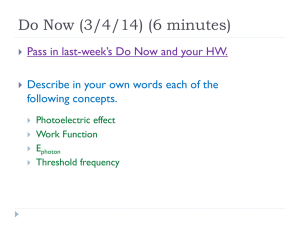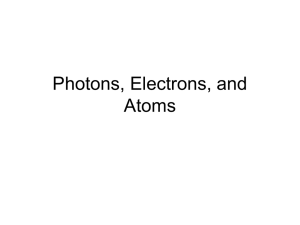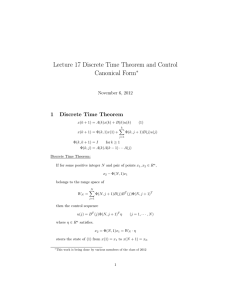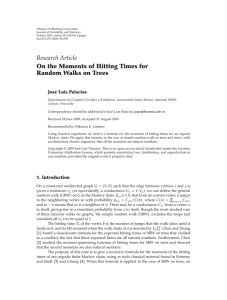PEF_Final-ash
advertisement
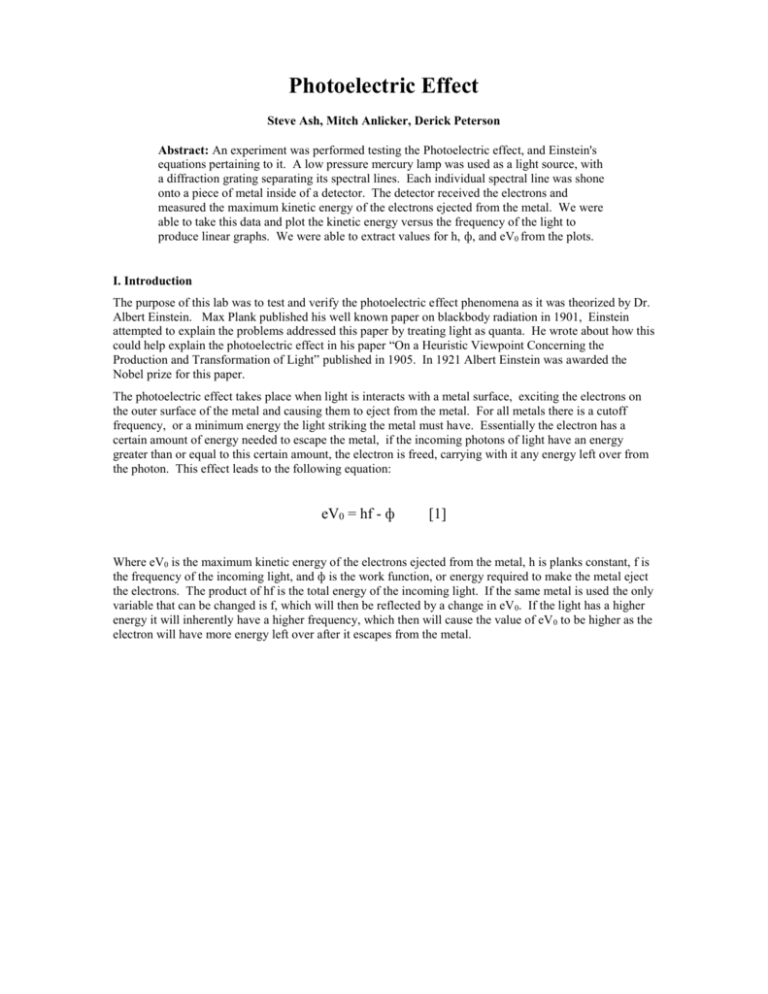
Photoelectric Effect Steve Ash, Mitch Anlicker, Derick Peterson Abstract: An experiment was performed testing the Photoelectric effect, and Einstein's equations pertaining to it. A low pressure mercury lamp was used as a light source, with a diffraction grating separating its spectral lines. Each individual spectral line was shone onto a piece of metal inside of a detector. The detector received the electrons and measured the maximum kinetic energy of the electrons ejected from the metal. We were able to take this data and plot the kinetic energy versus the frequency of the light to produce linear graphs. We were able to extract values for h, ф, and eV0 from the plots. I. Introduction The purpose of this lab was to test and verify the photoelectric effect phenomena as it was theorized by Dr. Albert Einstein. Max Plank published his well known paper on blackbody radiation in 1901, Einstein attempted to explain the problems addressed this paper by treating light as quanta. He wrote about how this could help explain the photoelectric effect in his paper “On a Heuristic Viewpoint Concerning the Production and Transformation of Light” published in 1905. In 1921 Albert Einstein was awarded the Nobel prize for this paper. The photoelectric effect takes place when light is interacts with a metal surface, exciting the electrons on the outer surface of the metal and causing them to eject from the metal. For all metals there is a cutoff frequency, or a minimum energy the light striking the metal must have. Essentially the electron has a certain amount of energy needed to escape the metal, if the incoming photons of light have an energy greater than or equal to this certain amount, the electron is freed, carrying with it any energy left over from the photon. This effect leads to the following equation: eV0 = hf - ф [1] Where eV0 is the maximum kinetic energy of the electrons ejected from the metal, h is planks constant, f is the frequency of the incoming light, and ф is the work function, or energy required to make the metal eject the electrons. The product of hf is the total energy of the incoming light. If the same metal is used the only variable that can be changed is f, which will then be reflected by a change in eV 0. If the light has a higher energy it will inherently have a higher frequency, which then will cause the value of eV 0 to be higher as the electron will have more energy left over after it escapes from the metal. II. Experimental Setup We used a low pressure mercury arc lamp, a diffraction grating, and a detector setup to measure the maximum energy of the electrons ejected from the metal. The apparatus was setup as shown below: Figure 1: This figure represents the experimental setup used to perform the lab. The mercury light passes through the diffraction grating and the light is separated into Hg's characteristic light spectrum. The detector is on a radial mount which allows it to move in an arc with the lamp at its center. This allows the detector to be moved in front of each individual band of color the diffraction grating produces. The detector also had a phosphorescent plate placed in front of the its opening, the plate has a thin slit cut into it, this is to minimize the chance of getting light with different wavelengths in the detector at the same time. The Hg light source produced a spectrum with 5 distinct lines 2 violet, one blue, one green, and one yellow. The spectrum appeared as pictured below: Figure 2: The picture represents the first order spectral lines produced by the diffraction grating on both sides of the bright center line. The detector was passed in front of each first and second order band individually; on both the left and right sides of the center line. Each time a measurement was made we made sure only light from the band being measured was passing through the slit in the mask, then used the detectors reset button to discharge any residual charge, and took a reading from the multimeter to see what the maximum kinetic energy of electrons being detected was. We repeated this 3 times for both the first and second order bands. III. Results We began analyzing our data by first calculating an average eV0 for each band, for both the first and second order lines. We averaged the readings from bands of the same order on both sides of the spectrum. Knowing the frequency of the incoming light, and the accepted value for h, we were able to then calculate hf, the total energy of the incoming light, and the work function ф. The following chart shows our calculated values for each band: Color Frequency Photon Energy (J) Photon Energy (eV) Avg eV0(V) Vo (J) Violet 2 8.20E+14 5.43E-19 3.391585518 Violet 1 7.41E+14 4.91E-19 3.064835206 1.695 2.72E19 1.369835 Blue 6.88E+14 4.56E-19 2.845622971 1.51667 2.43E19 1.328953 Green 5.49E+14 3.64E-19 2.270707865 0.91 1.46E19 1.360708 Yellow 5.19E+14 3.44E-19 2.146625468 0.795 1.27E19 1.351625 1.938333 3.11E19 Work Function(eV) Avg Work Function 1.453253 1.372875 The readings taken for each band were all close, but not consistent, so to adjust for this we took the average of the 6 readings for our calculations. To adjust for the fact that we did not get the exact same value ofeV 0 each time a particular band of light was measured we performed error analysis on our results. Since there should be an actual value for eV0 but we observe small fluctuations between measurements we assumed that the error should have a Gaussian nature, so we calculated our error accordingly. We generated standard deviation using the following formula: σ = ((1/N-1)*Ʃ di2)1/2 [2] Where σ is the standard deviation, N is the number of measurements taken, and d i is the deviation from the mean and is expressed by: di=xi-<x> [3] with xi being the measured value and <x> is the mean value of all measurements. Then to get a feel for the accuracy of our error at each point we also calculated the standard error in the mean using the following formula: σmean= σ/(N)1/2 [4] When σmean is calculated for each σ we are able to see the probability that our estimated σ will be accurate. Our calculated <x>, σ, and σmean for the measure value of eV0 for each frequency is displayed on the following chart: First Order Second Order Color <x> σ σmean Color <x> σ σmean Violet 2 1.938333 0.031842 0.012999 Violet 2 1.938333 0.008975 0.003664 Violet 1 1.695 0.012583 0.005137 Violet 1 1.681667 0.013844 0.005652 Blue 1.51667 0.007454 0.003043 Blue Green 0.91 0 0 Green 0.813333 0.127802 0.052175 Yellow 0.795 0.005 0.002041 Yellow 0.728333 0.058713 1.52 0.012019 0.004907 0.02397 Using our data we were able to plot a graph of eV0 versus frequency using our values of σ for our error bars. The graph is linear in nature and we are able to extract three primary pieces of experimental data out of it. The slope should be equal to h/e, Planck's constant divided by the elementary charge, it is h/e because eV0 is in electron volts, if converted to Joules first it will the slope will be equal to h. We also know that the x intercept value is the cutoff frequency for the metal, and the y intercept is ф. We analyzed both the first and the second order data in this manner, which yielded the following graphs: Figure 3: Intercept:-1.2125 Slope: 3.89439E-15 X-Intercept: 3.11.5E14 Figure 4: Intercept: -1.44833 Slope: 4.19756E-15 X-Intercept : 3.4504E14 When our plots are examined we can see that our values of h/e are 3.89439E-15 and 4.19756E-15 for first and second order respectively. This would give us a value for h of 6.2382E-34 for first order, and 6.7245E-34 for second order. These values average out to 6.48134E-34. You can also see our work function comes out to an average value of 1.33eV. The cutoff frequencies calculated for first and second order average out to 3.2819E14 Hz. In order to see how our results appeared with more statistics we combined our first and second order data to calculate new values which yielded the following graph: Figure 5: Intercept: -1.33043 Slope: 4.04597E-15 X-Intercept: 3.288E14 This graphs slope resulted in an experimental value for h of 6.48164E-34. It also has a value of 1.33eV+/.041eV for ф. IV. Discussion Most if not all of our values have fallen within acceptable values and have fairly small error. We can see from our values of σ that our larges standard deviation was for the yellow second order band, with a σ of .0587, which is about a12.4% deviation from the mean value. Every other measurement of sigma was less than the sigma for the yellow light, indicating that the data being taken was reasonably consistent. We must also compare our experimentally derived values against the theoretically accepted values in order to test the accuracy of our experiment. First we should look at Planck's constant, which can be derived from the slope of our graphs. Since we plotted eV0 in electron volts we have to simply multiply the value of our slope by 1.602E-19, the fundamental charge, to get the standard value for h. Our first order data had a calculated value of 6.2382E-34+/-2.613E-34 for h, which has a 5.85% error from the accepted value. The second order value of h was calculated to be 6.7245E-34+/-3.929E-35, which has a 1.487% error from the accepted value. When we combined our first and second order results we found our experimental h to be 6.48164E-34+/-3.236E-35, which has a 2.18% error from the accepted value. All of these errors show that the experiment itself was overall successful, with only small amounts of error affecting our results. The standard error in our second order results was higher in every case except the yellow light, which may have been due to the fact of it being of the lowest frequency, or even because it is in the middle of the visible spectrum and was susceptible to contamination from other light. We did expect to see higher error in the second order results due to the fact that the light is of lesser intensity and more spread out. We felt that a more focused beam with higher intensity would yield to most likely situation for the photons to transfer all of their energy in the collisions with the electrons in the metal. Even with the second order data being slightly less accurate, we did not feel that it was so much less accurate than the first order data as to skew our results when combined with the first order data. Our results stayed in the same range as when we only used the first and second order data, this is to be expected though. We had double the amount of data points we had, but half of the points were less accurate, which cause only small changes in our error. In order for less accurate data to be used for more accurate results, you must have a huge increase in the number of data points. As the number of data points taken increases the error will decrease, but less accurate data will require a large increase in the number of data points. References [2] [3] [4]Taylor, John R. An Introduction to Error Analysis: the Study of Uncertainties in Physical Measurements. Sausalito, CA: University Science, 1997. Print.
